Abstract
Increasing UVB radiation at the earth's surface might have adverse effects on in vivo immunologic responses in humans. We prospectively randomized subjects to test whether epicutaneous immunization is altered by prior administration of biologically equalized doses of UV radiation. Multiple doses of antigens on upper inner arm skin (UV protected) were used to elicit contact sensitivity responses, which were quantitated by measuring increases in skin thickness. If a dose of UVB sufficient to induce redness (erythemagenic) was administered to the immunization site prior to sensitization with dinitrochlorobenzene (DNCB), we noted a marked reduction in the degree of sensitization (P less than 0.0006) that was highly dose responsive (r = 0.98). Even suberythemagenic UV (less than a visible sunburn) resulted in a decreased frequency of strongly positive responses (32%) as compared to controls (73%) (P = 0.019). The rate of immunologic tolerance to DNCB (active suppression of a subsequent repeat immunization) in the groups that were initially sensitized on skin receiving erythemagenic doses of UV was 31% (P = 0.0003). In addition, a localized moderate sunburn appeared to modulate immunization with diphenylcyclopropenone through a distant, unirradiated site (41% weak responses) as compared to the control group (9%) (P = 0.05). Monitoring antigen presenting cell content in the epidermis revealed that erythemagenic regimens induced CD1a-DR+ macrophages and depleted Langerhans cells. In conclusion, relevant and even subclinical levels of UV exposure have significant down modulatory effects on the ability of humans to generate a T-cell-mediated response to antigens introduced through irradiated skin.
Full text
PDF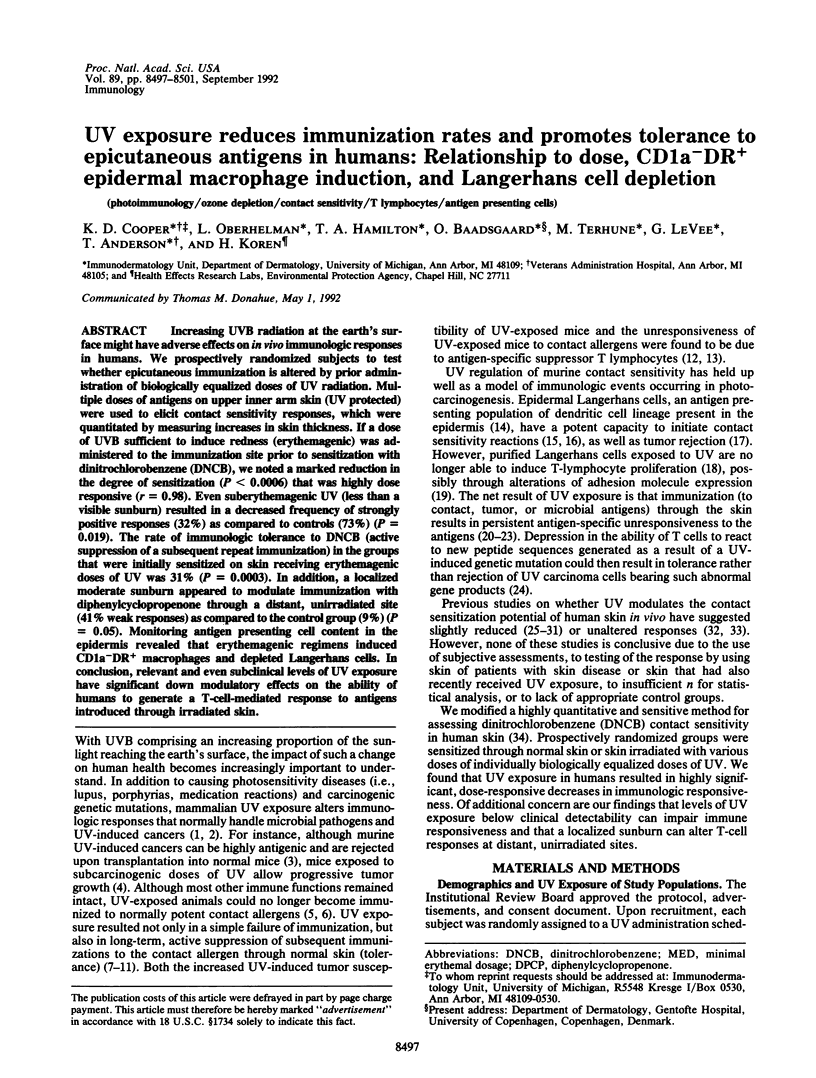
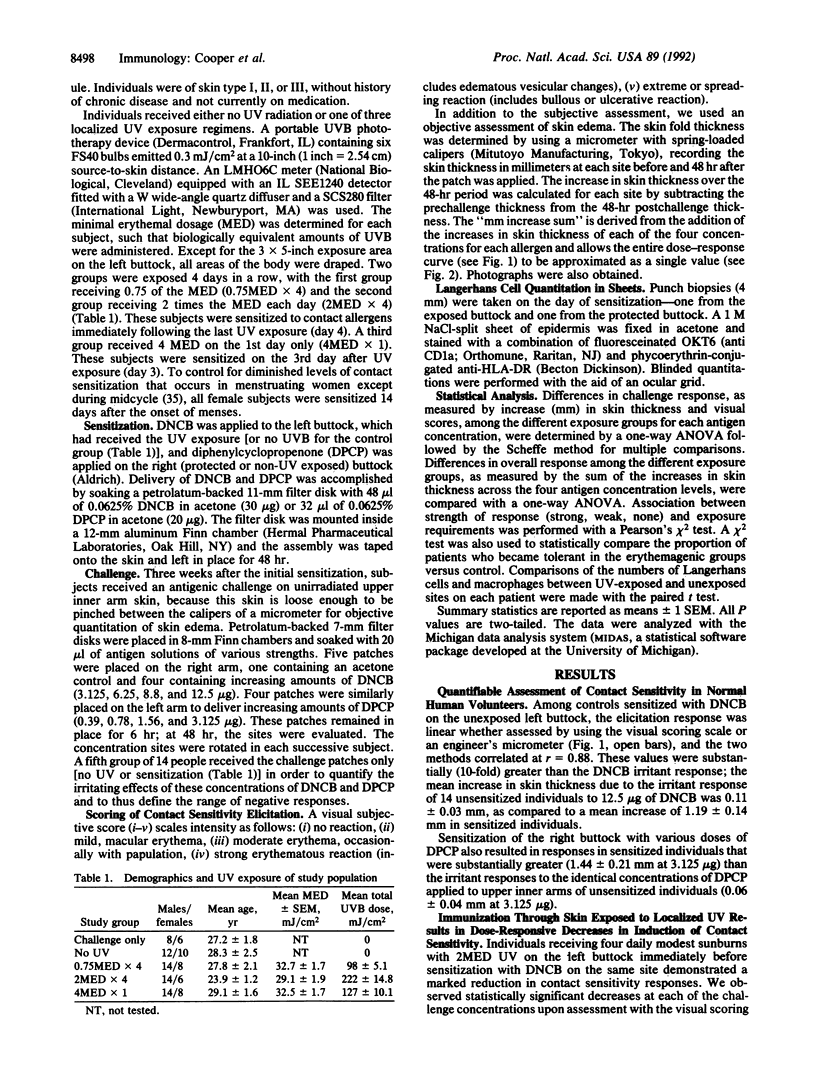
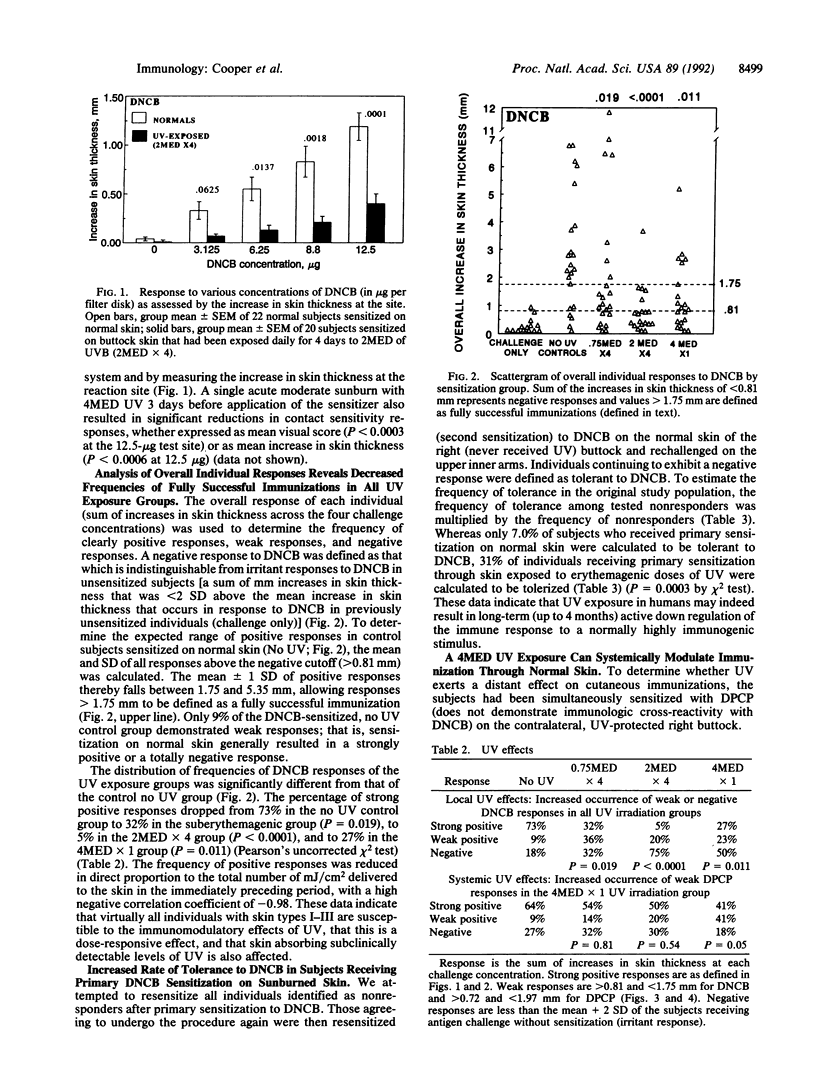
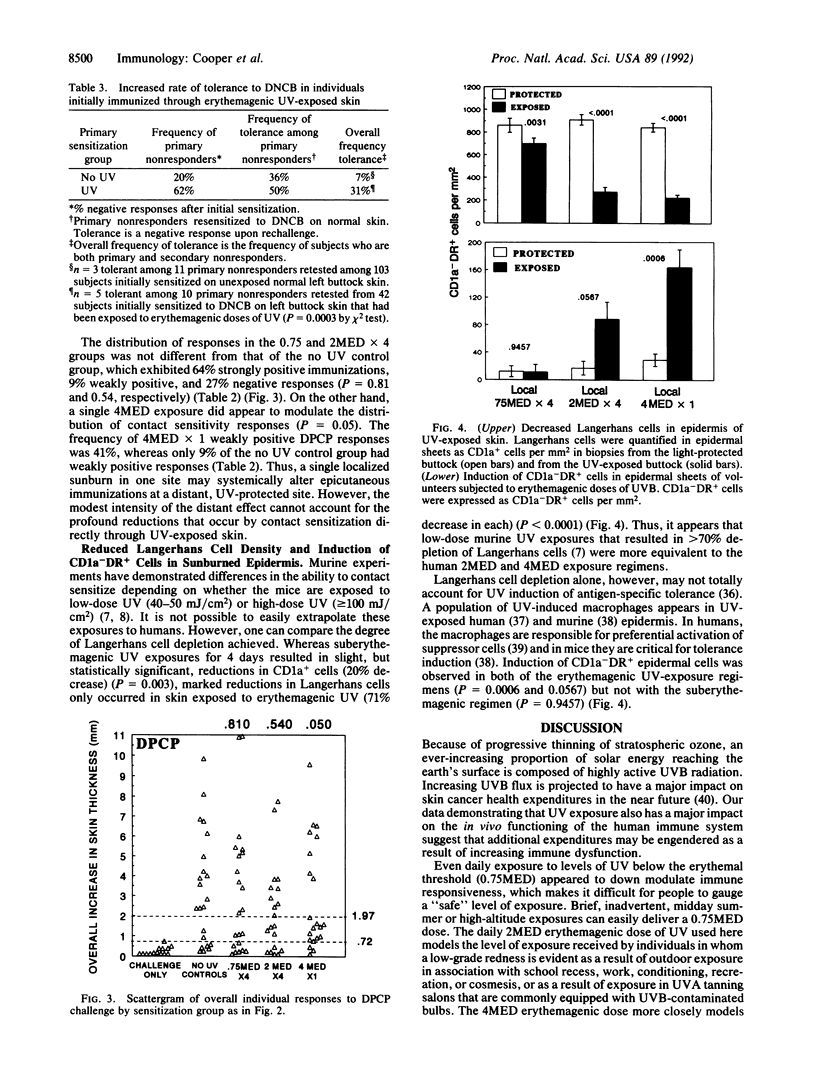
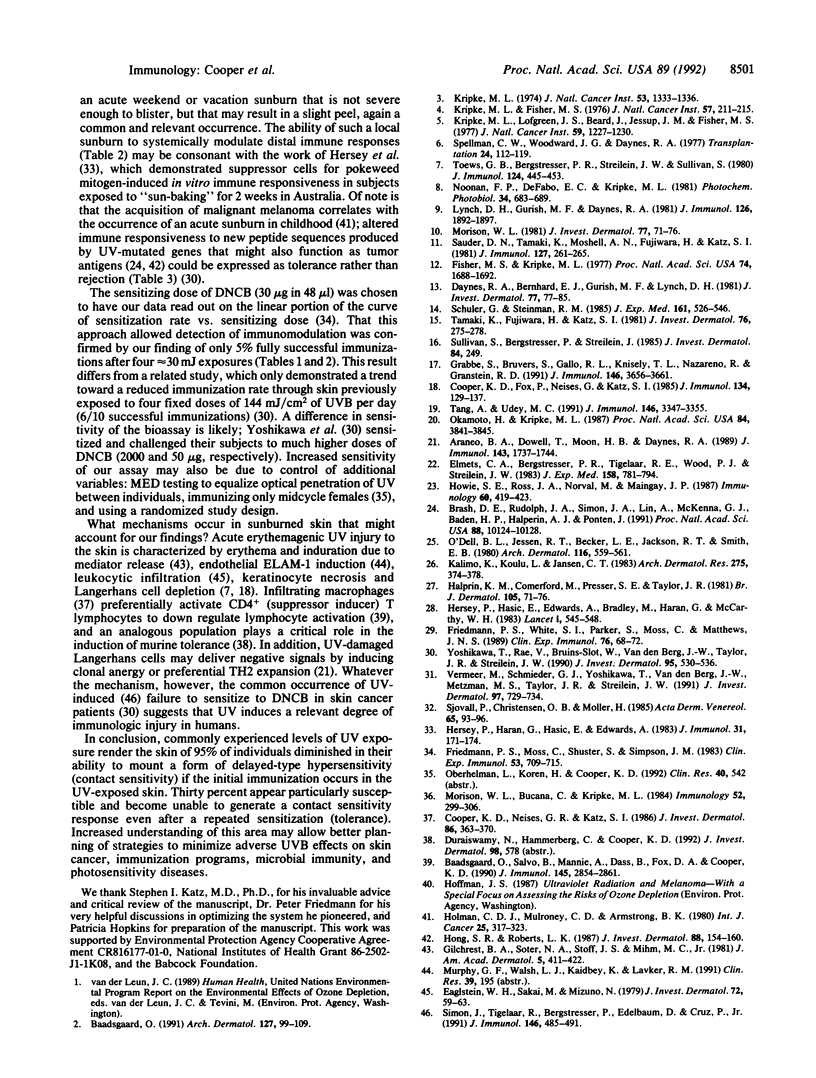
Selected References
These references are in PubMed. This may not be the complete list of references from this article.
- Araneo B. A., Dowell T., Moon H. B., Daynes R. A. Regulation of murine lymphokine production in vivo. Ultraviolet radiation exposure depresses IL-2 and enhances IL-4 production by T cells through an IL-1-dependent mechanism. J Immunol. 1989 Sep 15;143(6):1737–1744. [PubMed] [Google Scholar]
- Baadsgaard O. In vivo ultraviolet irradiation of human skin results in profound perturbation of the immune system. Relevance to ultraviolet-induced skin cancer. Arch Dermatol. 1991 Jan;127(1):99–109. [PubMed] [Google Scholar]
- Baadsgaard O., Salvo B., Mannie A., Dass B., Fox D. A., Cooper K. D. In vivo ultraviolet-exposed human epidermal cells activate T suppressor cell pathways that involve CD4+CD45RA+ suppressor-inducer T cells. J Immunol. 1990 Nov 1;145(9):2854–2861. [PubMed] [Google Scholar]
- Brash D. E., Rudolph J. A., Simon J. A., Lin A., McKenna G. J., Baden H. P., Halperin A. J., Pontén J. A role for sunlight in skin cancer: UV-induced p53 mutations in squamous cell carcinoma. Proc Natl Acad Sci U S A. 1991 Nov 15;88(22):10124–10128. doi: 10.1073/pnas.88.22.10124. [DOI] [PMC free article] [PubMed] [Google Scholar]
- Cooper K. D., Fox P., Neises G., Katz S. I. Effects of ultraviolet radiation on human epidermal cell alloantigen presentation: initial depression of Langerhans cell-dependent function is followed by the appearance of T6- Dr+ cells that enhance epidermal alloantigen presentation. J Immunol. 1985 Jan;134(1):129–137. [PubMed] [Google Scholar]
- Cooper K. D., Neises G. R., Katz S. I. Antigen-presenting OKM5+ melanophages appear in human epidermis after ultraviolet radiation. J Invest Dermatol. 1986 Apr;86(4):363–370. doi: 10.1111/1523-1747.ep12285600. [DOI] [PubMed] [Google Scholar]
- Daynes R. A., Bernhard E. J., Gurish M. F., Lynch D. H. Experimental photoimmunology: immunologic ramifications of UV-induced carcinogenesis. J Invest Dermatol. 1981 Jul;77(1):77–85. doi: 10.1111/1523-1747.ep12479260. [DOI] [PubMed] [Google Scholar]
- Eaglstein W. H., Sakai M., Mizuno N. Ultraviolet radiation-induced inflammation and leukocytes. J Invest Dermatol. 1979 Feb;72(2):59–63. doi: 10.1111/1523-1747.ep12530248. [DOI] [PubMed] [Google Scholar]
- Elmets C. A., Bergstresser P. R., Tigelaar R. E., Wood P. J., Streilein J. W. Analysis of the mechanism of unresponsiveness produced by haptens painted on skin exposed to low dose ultraviolet radiation. J Exp Med. 1983 Sep 1;158(3):781–794. doi: 10.1084/jem.158.3.781. [DOI] [PMC free article] [PubMed] [Google Scholar]
- Fisher M. S., Kripke M. L. Systemic alteration induced in mice by ultraviolet light irradiation and its relationship to ultraviolet carcinogenesis. Proc Natl Acad Sci U S A. 1977 Apr;74(4):1688–1692. doi: 10.1073/pnas.74.4.1688. [DOI] [PMC free article] [PubMed] [Google Scholar]
- Friedmann P. S., Moss C., Shuster S., Simpson J. M. Quantitative relationships between sensitizing dose of DNCB and reactivity in normal subjects. Clin Exp Immunol. 1983 Sep;53(3):709–715. [PMC free article] [PubMed] [Google Scholar]
- Friedmann P. S., White S. I., Parker S., Moss C., Matthews J. N. Antigenic stimulation during ultraviolet therapy in man does not result in immunological tolerance. Clin Exp Immunol. 1989 Apr;76(1):68–72. [PMC free article] [PubMed] [Google Scholar]
- Gilchrest B. A., Soter N. A., Stoff J. S., Mihm M. C., Jr The human sunburn reaction: histologic and biochemical studies. J Am Acad Dermatol. 1981 Oct;5(4):411–422. doi: 10.1016/s0190-9622(81)70103-8. [DOI] [PubMed] [Google Scholar]
- Grabbe S., Bruvers S., Gallo R. L., Knisely T. L., Nazareno R., Granstein R. D. Tumor antigen presentation by murine epidermal cells. J Immunol. 1991 May 15;146(10):3656–3661. [PubMed] [Google Scholar]
- Halprin K. M., Comerford M., Presser S. E., Taylor J. R. Ultraviolet light treatment delays contact sensitization to nitrogen mustard. Br J Dermatol. 1981 Jul;105(1):71–76. doi: 10.1111/j.1365-2133.1981.tb00884.x. [DOI] [PubMed] [Google Scholar]
- Hersey P., Bradley M., Hasic E., Haran G., Edwards A., McCarthy W. H. Immunological effects of solarium exposure. Lancet. 1983 Mar 12;1(8324):545–548. doi: 10.1016/s0140-6736(83)92808-8. [DOI] [PubMed] [Google Scholar]
- Hersey P., Haran G., Hasic E., Edwards A. Alteration of T cell subsets and induction of suppressor T cell activity in normal subjects after exposure to sunlight. J Immunol. 1983 Jul;131(1):171–174. [PubMed] [Google Scholar]
- Holman C. D., Mulroney C. D., Armstrong B. K. Epidemiology of pre-invasive and invasive malignant melanoma in Western Australia. Int J Cancer. 1980 Mar 15;25(3):317–323. doi: 10.1002/ijc.2910250303. [DOI] [PubMed] [Google Scholar]
- Hong S. R., Roberts L. K. Cross-reactive tumor antigens in the skin of mice exposed to subcarcinogenic doses of ultraviolet radiation. J Invest Dermatol. 1987 Feb;88(2):154–160. doi: 10.1111/1523-1747.ep12525297. [DOI] [PubMed] [Google Scholar]
- Howie S. E., Ross J. A., Norval M., Maingay J. P. In vivo modulation of antigen presentation generates Ts rather than TDH in HSV-1 infection. Immunology. 1987 Mar;60(3):419–423. [PMC free article] [PubMed] [Google Scholar]
- Kalimo K., Koulu L., Jansén C. T. Effect of a single UVB or PUVA exposure on immediate and delayed skin hypersensitivity reactions in humans. Correlation to erythemal response and Langerhans cell depletion. Arch Dermatol Res. 1983;275(6):374–378. doi: 10.1007/BF00417336. [DOI] [PubMed] [Google Scholar]
- Kripke M. L. Antigenicity of murine skin tumors induced by ultraviolet light. J Natl Cancer Inst. 1974 Nov;53(5):1333–1336. doi: 10.1093/jnci/53.5.1333. [DOI] [PubMed] [Google Scholar]
- Kripke M. L., Fisher M. S. Immunologic parameters of ultraviolet carcinogenesis. J Natl Cancer Inst. 1976 Jul;57(1):211–215. doi: 10.1093/jnci/57.1.211. [DOI] [PubMed] [Google Scholar]
- Kripke M. L., Lofgreen J. S., Beard J., Jessup J. M., Fisher M. S. In vivo immune responses of mice during carcinogenesis by ultraviolet irradiation. J Natl Cancer Inst. 1977 Oct;59(4):1227–1230. doi: 10.1093/jnci/59.4.1227. [DOI] [PubMed] [Google Scholar]
- Lynch D. H., Gurish M. F., Daynes R. A. Relationship between epidermal Langerhans cell density ATPase activity and the induction of contact hypersensitivity. J Immunol. 1981 May;126(5):1892–1897. [PubMed] [Google Scholar]
- Morison W. L., Bucana C., Kripke M. L. Systemic suppression of contact hypersensitivity by UVB radiation is unrelated to the UVB-induced alterations in the morphology and number of Langerhans cells. Immunology. 1984 Jun;52(2):299–306. [PMC free article] [PubMed] [Google Scholar]
- Morison W. L. Photoimmunology. J Invest Dermatol. 1981 Jul;77(1):71–76. doi: 10.1111/1523-1747.ep12479254. [DOI] [PubMed] [Google Scholar]
- Noonan F. P., De Fabo E. C., Kripke M. L. Suppression of contact hypersensitivity by UV radiation and its relationship to UV-induced suppression of tumor immunity. Photochem Photobiol. 1981 Dec;34(6):683–689. [PubMed] [Google Scholar]
- O'Dell B. L., Jessen R. T., Becker L. E., Jackson R. T., Smith E. B. Diminished immune response in sun-damaged skin. Arch Dermatol. 1980 May;116(5):559–561. [PubMed] [Google Scholar]
- Okamoto H., Kripke M. L. Effector and suppressor circuits of the immune response are activated in vivo by different mechanisms. Proc Natl Acad Sci U S A. 1987 Jun;84(11):3841–3845. doi: 10.1073/pnas.84.11.3841. [DOI] [PMC free article] [PubMed] [Google Scholar]
- Sauder D. N., Tamaki K., Moshell A. N., Fujiwara H., Katz S. I. Induction of tolerance to topically applied TNCB using TNP-conjugated ultraviolet light-irradiated epidermal cells. J Immunol. 1981 Jul;127(1):261–265. [PubMed] [Google Scholar]
- Schuler G., Steinman R. M. Murine epidermal Langerhans cells mature into potent immunostimulatory dendritic cells in vitro. J Exp Med. 1985 Mar 1;161(3):526–546. doi: 10.1084/jem.161.3.526. [DOI] [PMC free article] [PubMed] [Google Scholar]
- Simon J. C., Tigelaar R. E., Bergstresser P. R., Edelbaum D., Cruz P. D., Jr Ultraviolet B radiation converts Langerhans cells from immunogenic to tolerogenic antigen-presenting cells. Induction of specific clonal anergy in CD4+ T helper 1 cells. J Immunol. 1991 Jan 15;146(2):485–491. [PubMed] [Google Scholar]
- Sjövall P., Christensen O. B., Möller H. Single exposure to ultraviolet irradiation and elicitation of human allergic contact dermatitis. Acta Derm Venereol. 1985;65(2):93–96. [PubMed] [Google Scholar]
- Spellman C. W., Woodward J. G., Daynes R. A. Modification of immunological potential by ultraviolet radiation. I. Immune status of short-term UV-irradiated mice. Transplantation. 1977 Aug;24(2):112–119. doi: 10.1097/00007890-197708000-00004. [DOI] [PubMed] [Google Scholar]
- Sullivan S., Bergstresser P. R., Streilein J. W. Intravenously injected, TNP-derivatized, Langerhans cell-enriched epidermal cells induce contact hypersensitivity in Syrian hamsters. J Invest Dermatol. 1985 Apr;84(4):249–252. doi: 10.1111/1523-1747.ep12265316. [DOI] [PubMed] [Google Scholar]
- Tamaki K., Fujiwara H., Katz S. I. The role of epidermal cells in the induction and suppression of contact sensitivity. J Invest Dermatol. 1981 Apr;76(4):275–278. doi: 10.1111/1523-1747.ep12526115. [DOI] [PubMed] [Google Scholar]
- Tang A., Udey M. C. Inhibition of epidermal Langerhans cell function by low dose ultraviolet B radiation. Ultraviolet B radiation selectively modulates ICAM-1 (CD54) expression by murine Langerhans cells. J Immunol. 1991 May 15;146(10):3347–3355. [PubMed] [Google Scholar]
- Toews G. B., Bergstresser P. R., Streilein J. W. Epidermal Langerhans cell density determines whether contact hypersensitivity or unresponsiveness follows skin painting with DNFB. J Immunol. 1980 Jan;124(1):445–453. [PubMed] [Google Scholar]
- Vermeer M., Schmieder G. J., Yoshikawa T., van den Berg J. W., Metzman M. S., Taylor J. R., Streilein J. W. Effects of ultraviolet B light on cutaneous immune responses of humans with deeply pigmented skin. J Invest Dermatol. 1991 Oct;97(4):729–734. doi: 10.1111/1523-1747.ep12484259. [DOI] [PubMed] [Google Scholar]
- Yoshikawa T., Rae V., Bruins-Slot W., Van den Berg J. W., Taylor J. R., Streilein J. W. Susceptibility to effects of UVB radiation on induction of contact hypersensitivity as a risk factor for skin cancer in humans. J Invest Dermatol. 1990 Nov;95(5):530–536. doi: 10.1111/1523-1747.ep12504877. [DOI] [PubMed] [Google Scholar]


